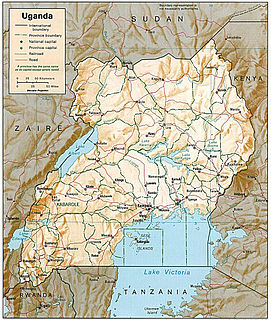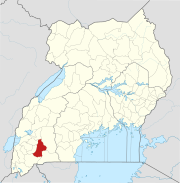
Bushenyi is a town in Western Uganda. It is the 'chief town' of Bushenyi District and the district headquarters are located there. The district is named after the town, in keeping with the practice in most of the districts in the country.
The Mbarara Northern Bypass Road is a road that bypasses the northern part of Mbarara City.
The Mukono–Kyetume–Katosi–Nyenga Road is a road in the Central Region of Uganda, connecting the towns of Mukono, Kyetume and Katosi in Mukono District to Nkokonjeru and Nyenga in Buikwe District.

Sanga Town, also known as Sanga, is an urban center in the Kiruhura District, Ankole sub-region, in the Western Region of Uganda.
The Ishaka–Kagamba Road is a road in the Western Region of Uganda, connecting the town of Kagamba in Ntungamo District with Ishaka in Bushenyi District.
Kabale–Kisoro–Bunagana Road is a road in Western Uganda, connecting the towns of Kabale with the towns of Kisoro, Bunagana, at the border with the Democratic Republic of the Congo and Kyanika at the border with Rwanda.
The Nyakahita–Kazo–Kamwenge–Fort Portal Road is a road in the Western Region of Uganda, connecting the towns of Nyakahita and Kazo in Kiruhura District, Ibanda in Ibanda District, Kamwenge in Kamwenge District, and Fort Portal in Kabarole District.

Kazo is a town in the Western Region of Uganda.
The Kyenjojo–Kabwoya Road, in the Western Region of Uganda, connects the town of Kyenjojo in the Kyenjojo District with Kabwoya in the Hoima District. The road is part of the 238 kilometres (148 mi) Kyenjojo–Hoima–Masindi–Kigumba road corridor.
Tororo–Mbale–Soroti Road is a road in Eastern Uganda, connecting the towns of Tororo in Tororo District to Mbale in Mbale District and Soroti in Soroti District.
The Soroti–Dokolo–Lira Road is a road in Uganda, connecting the towns of Soroti in Soroti District, Dokolo in Dokolo District, and Lira in Lira District.
Ntungamo–Rukungiri Road is in the Western Region of Uganda, connecting the towns of Ntungamo in Ntungamo District with Rukungiri in Rukungiri District.
The Kampala–Mpigi Expressway, also Busega–Mpigi Expressway, is a proposed four-lane, dual carriage highway in the Central Region of Uganda, connecting, Kampala, the capital city, and Mpigi, the headquarters of Mpigi District.
Letshego Microfinance Uganda,, whose official name is Letshego Uganda Limited, is a Tier IV microfinance institution in Uganda.
Rukiga District is a district in Western Uganda. Its capital is Mparo. However, the largest urban center in the district is Muhanga.

Muhanga is a town in the Western Region of Uganda. It is the main commercial centre and largest town of Rukiga District. However, the district headquarters are located at Mparo.











